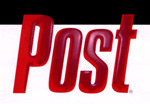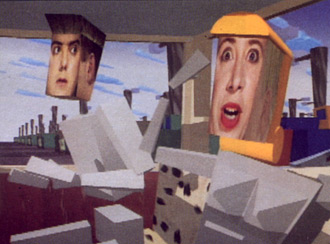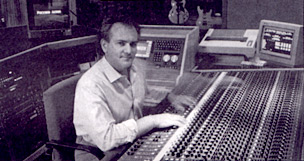

Focused Audio's solid work for Liquid TV

|
For Blockheads, Colossal Pictures combines CGI and live action. Roth and crew determined the character of the sound by the look, feel and pace of the animation. |
SAN FRANCISCO, CA–If you watch television–and you know you do–you've seen more and more animation as the central format for commercials and music videos. Truly amazing animation seems to spring fully blown from the screen. But like any seemingly overnight sensation, there was a long road that went into perfecting animation techniques, and the proving ground for some of what shows up on mainstream television these days has come from MTV's seminal Liquid Television program, now in its third season. And as with other visual forms, audio has closely paralleled animation's stylistic changes. In fact, in many instances the animation would seem incomplete without its respective audio.
Focused Audio, a San Francisco post production house, has been part of Liquid Television's sound since its inception, and the upcoming season's audio for the program is very much as cutting edge as its visuals. Of 14 segments produced for the new season, Focused Audio handled the audio for nine of them, accounting for approximately one hour of animation.
According to sound supervisor and mixer Jeff Roth, the productions are staggering in their diversity and ambient requirements. "They all presented a challenge individually," says Roth. The series consisted of traditional cel animation, cut-out animation and combinations of techniques, what Colossal Pictures [the SF-based facility which produces animation for the show] refers to as "blendo." In the case of The Blockheads segments, director Eli Noyes combined computer-generated images with live-action footage. "Each segment called for a unique sound design approach," continues Roth. "The character of the sound was determined by the animation's look, feel and pace, as well as the story line. We drew from the ideas of the animators and directors and developed the elements from there."
Eight different producer/director teams began working early on the project with Focused Audio's staff, including Roth and sound designers Mark Pittman, Tom Vonderhaar and Gordon Lyon. Pittman mixed most of the shows. Shawn Cuddy was the coordinating producer for Colossal Pictures, which produced the visuals. The audio post process started not in the studio but on the telephone a month earlier, with scheduling for spotting sessions set up between the production teams and Focused Audio's sound designers. An eight-page list detailed the process, including a specification not to use SMPTE time code values from computer editing and design stations; rather, all time code had to be pulled off the window burn on the work tapes.
"It was essential that time code numbers be accurate down to the frame for a project like this," explains Roth. "Otherwise, the whole spotting process would be a waste of time." Dialogue editing and conforming specified the creation and delivery of clean and accurate CMX lists.
"Experience showed us that trying to use cleaned CMX lists from pix edits doesn't work," says Roth. "Those lists invariably get at least a generation away from the original SMPTE number which accompanies the audio when it leaves the studio. So we instructed our people to put aside extra time to create new CMX lists to final locked picture after the online edits were completed. We also delineated a process using Dolby SR on mag tracks for achieving clean dialogue on segments edited on film."

|
Focused Audio's Roth calls the Liquid TV productions staggering in their diversity and ambient requirements. |
Other specifications included delivering both stereo mixes and M&E tracks for overseas distribution. Using D-2 as the final layback format, the stereo tracks were placed on D-2 tracks one and two, with track three holding a separate dialogue track and track four having effects and music in mono. The equipment used includes a pair of eight-track WaveFrame digital audio workstations–a WaveFrame 1000 with both 32 MB and 16 MB samplers handling 24-bit audio, and a WaveFrame DCS which, with the optional editorial software package, was used for editing the audio tracks. Signal passed through a 40-input Sony JH 636 with DiskMix II-Plus automation. The DAT deck was a Panasonic 3700. An AKG 414 was the workhorse microphone for much of the dialogue and sampling work. Sourcing the sound effects came from both Focused Audio's library selections and a sizable in-house library the studio has created.
The raw sounds were fairly heavily manipulated, says Roth, in search of original and different effects. "What we were seeing here were requests for a very wide range of sound effects for all these pieces. In one instance, for example, the director was asking for a combination of authentic documentary sounds contrasted with cartoon-like sound effects. We did a lot of Foley direct to picture, about 10 to 15 percent of each segment. In fact, Prudence Fenton, who was the executive producer for Colossal Pictures, at one point went out to her car and got her high heels and came in and did footsteps. That really tells you a lot about the atmosphere during this process: it was highly structured but at the same time, it was an atmosphere in which everyone was free to contribute."
Car and Scooter Sounds:
One episode of The Blockheads, which features human faces on squared-off animated figures, needed specialized car sounds.
According to Mark Pittman, "We needed a basic engine sound, which I pulled from a library and combined with an electric motor sound. It gave us a totally different type of motor effect, one that fit the scene that was set sometime in an unspecified future period. We ran the pitch up and down on the combined sound for acceleration and stopping effects. When we needed to have the sound reflect the fact that the point of view was from outside the car, I added a third sound, another electric motor."
The equalization was also varied to reflect changing POVs. More automotive sounds are created on Crazy Daisy Ed, which features the actual sounds of a 1974 Vespa motor scooter. "There were no really good, authentic Vespa sounds in any library," says Roth. "So we went out and found one for rent a few blocks away. We thought the sound was significant so we went to the trouble of running mic lines out in front of the building." To the newly sampled Vespa were added dirt bike sounds for revving sounds and tire squeals for speed effects.
The Dangwoods is a mix of Burt Reynolds hillbilly films from the 1970s and Looney Tunes. At any one time, says Roth, there were up to a dozen sound effects layered together and playing simultaneously. The piece is very kinetic and the audio, with its crashes and bashes, keeps pace. "The producers wanted it realistic and cartoony at the same time," recalls Roth. "Layering a lot of sounds achieved that effect with low-end rumbles combined with cartoon-like 'boings' and rattles."
With such a dense audio bed to work from, the dialogue had to be laid in carefully. At times, small but critical amounts of high-frequency EQ–in the 5 kHz to 6 kHz range–were added to the dialogue to help it ride above the cacophonous track. "Just enough for bite but not so much as to make it overwhelm the music and effects tracks," says Pittman. "We also had to make a lot of mixing decisions on that episode since there were moments when one element or another would drop out."
Big City is set to a rap track created in Los Angeles. The track arrived on an Alesis ADAT-format tape with three mixes requested by Focused Audio: a dry mix, a wet mix with effects, and a music-minus mix with a separate vocal track. "We had been having discussions about this one with the producers in Los Angeles and with Colossal Pictures even before the tracks were recorded," says Roth. "We knew that there could potentially be changes to the audio."
Changes there were, including one requested by Colossal to extend the rap's groove through two otherwise silent sequences. The last one didn't quite match the beat to picture, so it provided a rare case in which picture was conformed to audio, he explains. There was also a request from MTV to change a line in the rap.
"We were able to do that since we had requested the separate mixes earlier," he says, adding that the rap performer flew up to Focused Audio to make the change. "It's a good example of how pre-planning makes a complex project like this doable with the budget and the schedule. We had the elements on hand to make the necessary changes without having to wait for a re-mix from Los Angeles."
On another segment, the director was looking for a performance akin to that found in old radio shows–live. Instead of recording each performer individually, four microphones were set up at a table and the actors read their scripts and performed ensemble, working with a stop watch to stay within timings for the animation and recording to a 24-track deck with Dolby SR noise reduction. The part also called for a guitar to be played by one of the characters, so a guitar amplifier was set up in an adjacent studio to lay down a rough guitar track in real-time with the actors. "They were walking out with virtually final audio from that session," says Pittman. "It had a real, live radio sort of feel to it. There was no editing of the dialogue later. Only the guitar part was overdubbed later."
Roth and Pittman attribute Focused Audio's success with complicated projects like Liquid Television to the company's own diverse background, which includes theatrical and network films for A&E, HBO and Showtime, as well as commercials and episodic series work, including 65 segments thus far for Lorimar Productions. "We run a shop that's creatively driven," says Roth. "As complex as our job gets, we realize that it's just as complex for each producer/director team throughout every phase of their projects. What they're looking for from us is input–to take what we know about, what we can do and try to match that to their visions. That's something any audio house has to do, from the spotting session to the final mix. You've got to be able to cover a lot of stylistic bases in an organized way."
Even as Liquid Television is airing this season, Focused Audio has its next set of plans in the springboard stage. These include more work in the Bay Area's fastest growing multimedia niche, an area in which animation is heavily featured, and working nationally with producers through the Ednet Digital Patch System, which Roth sees as a real-time mixing and review process for sound design and music projects.
"The patch system is often looked at as a tool for voice-overs," says Roth. "But we see it as a networking tool that can handle tasks far more complex than that. Very soon I expect all ad agencies and their clients to be on the network themselves, reviewing picture and sound work without having to leave their offices."
Post Magazine, February 1994